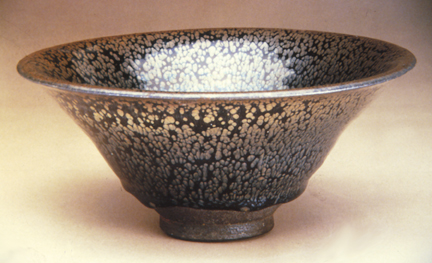
HARE'S FUR TEMMOKU BOWL,
Song Dynasty China, 1127-1279 CE, 7.5" d.
ART 198 - HISTORY OF WORLD CERAMICS
| In addition to the Imperial Wares of the Song dynasty (Ding, Jun, Ru, Guan, and Ge) other types of pottery were created for use by the population at large. Many of the glazes still used today were refined during this time, including celadons (first seen in Yueh ware) and another famous glaze, seen in this example, temmoku. Temmoku is a Japanese rendering of the Chinese term, Tianmu, actually a place name. It is said that Japanese Buddhist monks who travelled to China to study and meditate, found bowls such as this being used for tea and found them desirable. They were brought back to Japan, and local potters there eventually duplicated the effect. Temmoku is a name given to any high temperature stoneware or porcelain glaze that is extremely high in iron oxide content, in fact, saturated with it. During the firing the excess iron oxide migrates to the surface of the glaze where it collects into spots of pure metallic iron. This effect can be seen in this famous example. Note the very dark and coarse stoneware clay exposed at the footring. This area was left unglazed to prevent the thick application of temmoku glaze from running off the piece. Contemporary potters who have attempted to recreate this effect have found that a thick application of glaze is essential, and moreover, that an application of an iron bearing slip below the iron saturated temmoku glaze also aids in the development of the 'hare's fur' effect. The glaze is so named for its resemblance to the fur of a rabbit. Another variation is known as 'oil spot' temmoku, in which a network of tiny spots of iron oxide float in the glaze surface. Often, these two effects are quite similar. Bowls such as this found great popularity in cha-no-yu, more commonly known as the tea ceremony. | HARE'S FUR TEMMOKU BOWL, Song Dynasty China, 1127-1279 CE, 7.5" d. |
|
|